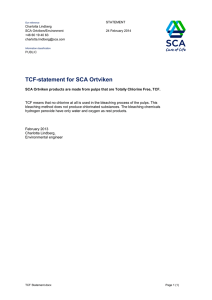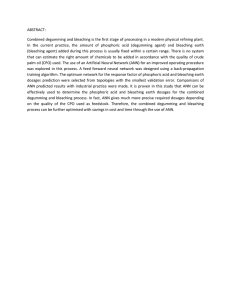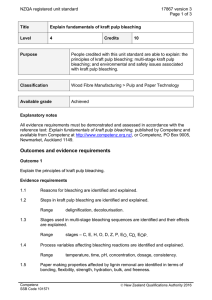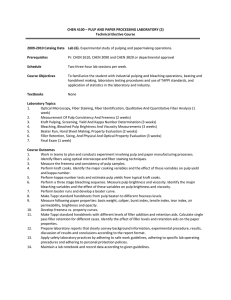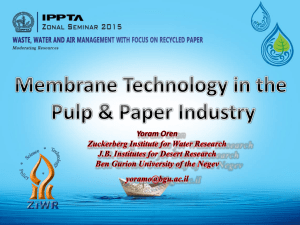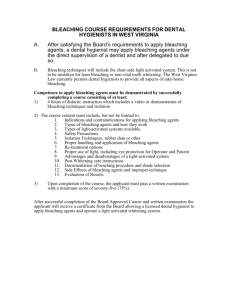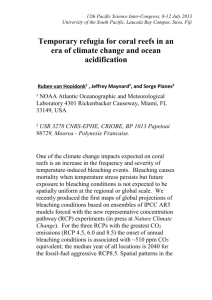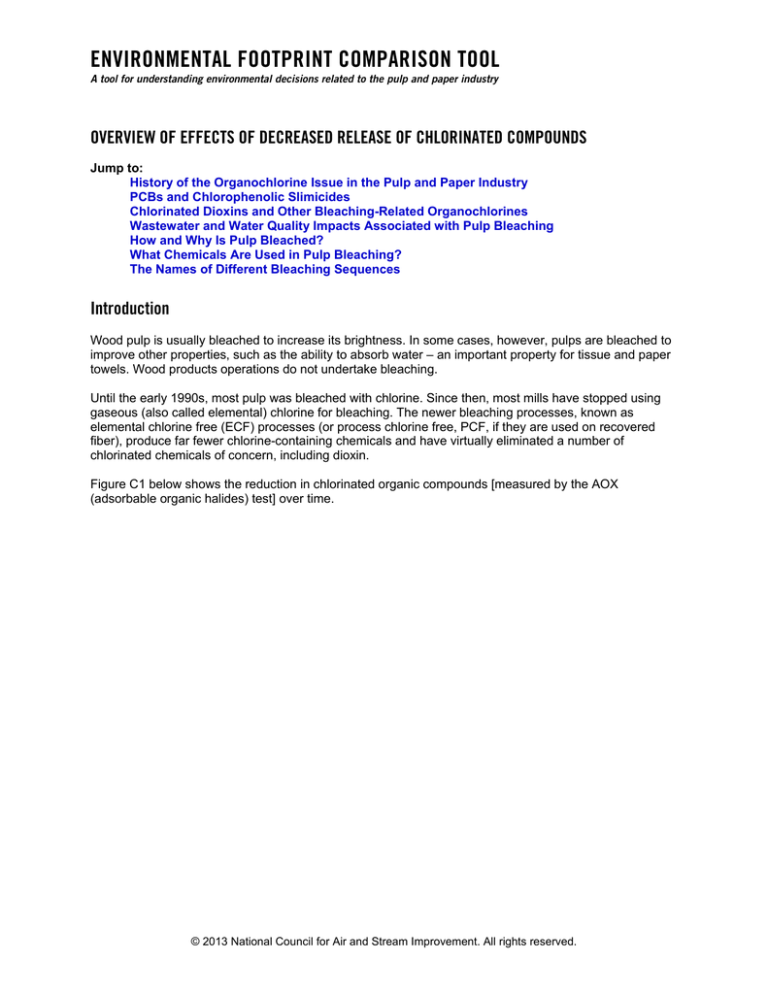
ENVIRONMENTAL FOOTPRINT COMPARISON TOOL
A tool for understanding environmental decisions related to the pulp and paper industry
OVERVIEW OF EFFECTS OF DECREASED RELEASE OF CHLORINATED COMPOUNDS
Jump to:
History of the Organochlorine Issue in the Pulp and Paper Industry
PCBs and Chlorophenolic Slimicides
Chlorinated Dioxins and Other Bleaching-Related Organochlorines
Wastewater and Water Quality Impacts Associated with Pulp Bleaching
How and Why Is Pulp Bleached?
What Chemicals Are Used in Pulp Bleaching?
The Names of Different Bleaching Sequences
Introduction
Wood pulp is usually bleached to increase its brightness. In some cases, however, pulps are bleached to
improve other properties, such as the ability to absorb water – an important property for tissue and paper
towels. Wood products operations do not undertake bleaching.
Until the early 1990s, most pulp was bleached with chlorine. Since then, most mills have stopped using
gaseous (also called elemental) chlorine for bleaching. The newer bleaching processes, known as
elemental chlorine free (ECF) processes (or process chlorine free, PCF, if they are used on recovered
fiber), produce far fewer chlorine-containing chemicals and have virtually eliminated a number of
chlorinated chemicals of concern, including dioxin.
Figure C1 below shows the reduction in chlorinated organic compounds [measured by the AOX
(adsorbable organic halides) test] over time.
© 2013 National Council for Air and Stream Improvement. All rights reserved.
Effects of Decreased Release of Chlorinated Compounds
General Overview
4.5
4
AOX in Effluent, kg/tonne pulp
3.5
3
2.5
2
1.5
1
0.5
0
1975
1980
1985
1990
1995
2000
2005
2010
Figure C1. Reduction in Adsorbable Organic Halides (AOX) over Time
(Source: NCASI 2012; AF&PA 2012)
To make further reductions beyond this, the bleach plant cannot be considered in isolation from the rest
of the mill. Some of the approaches for further reducing the use of chlorine-based bleaching agents
involve additional removal of lignin during pulping. Others involve using recovered bleach plant
wastewaters (also called filtrates) for washing of unbleached pulps, an approach that sends
organochlorine compounds to the mill’s pulping liquor recovery process where they are burned. The
recovery process, however, is sensitive and must be closely controlled to prevent safety and corrosion
problems.
Whether these types of measures can be used at a mill to further reduce organochlorine chemical
discharges will depend upon a host of site-specific factors, including existing mill equipment
configurations and capacity, wood species pulped, and product quality concerns. Opportunities will be
greatest for newly constructed mills or those undergoing significant modernization.
Below is more detailed information on pulp bleaching and the chemicals that can be formed during
bleaching.
References
American Forest and Paper Association (AF&PA). 2012. 2012 AF&PA sustainability report. Washington,
DC: American Forest and Paper Association.
National Council for Air and Stream Improvement (NCASI). 2012. File information.
© 2013 National Council for Air and Stream Improvement. All rights reserved.
Effects of Decreased Release of Chlorinated Compounds
General Overview
History of the Organochlorine Issue in the Pulp and Paper Industry
As far back as the 1970s, the paper industry was responding to concerns about the use of chlorophenolic
slimicides in paper production and the contamination of the wastepaper supply with polychlorinated
biphenyls (PCBs). These activities, however, were prelude to another unsuspected consequence of the
industry’s manufacturing practices.
A defining moment for the industry was the 1986 association of elemental chlorine-based bleaching with
the presence of dioxins, most notably the specific dioxin compound 2,3,7,8-tetrachlorodibenzo-p-dioxin
(2,3,7,8-TCDD). That association would spawn more than a decade of technical studies, governmental
scrutiny and rulemaking, and judicial action.
The industry worldwide would subsequently abandon elemental chlorine bleaching (using Cl2) in
deference to elemental chlorine free bleaching (ECF), enhanced ECF (EECF) involving oxygen
delignification and/or extended cooking, and, to a much lesser extent, totally chlorine free (TCF)
bleaching. The dynamics of this transition in North America are illustrated in Figure C2.
Bleaching practices for mechanical pulps did not typically involve use of chlorinated compounds and,
hence, dioxins and other organochlorines were not an issue. The use of sodium hypochlorite for
bleaching recycled fiber was implicated in the release of chloroform from bleach plant vents and
wastewaters. For that reason, it is rarely used today. Though use of sodium hypochlorite in mechanical
pulping is not regulated, any use of chlorine and chlorine dioxide at these facilities in the U.S. is subject to
controls mandated by the provisions of 1998 regulations adopted to control emissions of hazardous air
pollutants from pulp and paper industry sources. The same is true for secondary fiber.
The U.S. Environmental Protection Agency ultimately published effluent limitations effectively requiring
the termination of the use of elemental chlorine for pulp bleaching. EPA’s decision reflected recognition
that ECF would be sufficient to accommodate water quality concerns and that to go further would impose
capital cost requirements that would be financially debilitating to a large segment of the industry. Water
quality improvements following ECF application have led to a widespread decline in the number of
receiving streams downstream of paper mills that were characterized as impaired due to the presence of
dioxins.
Figure C2. World Bleached Chemical Pulp Production: 1990-2010
(AET at http://www.aet.org/science_of_ecf/eco_risk/2010_pulp.html)
© 2013 National Council for Air and Stream Improvement. All rights reserved.
Effects of Decreased Release of Chlorinated Compounds
General Overview
In parallel, a number of companies, particularly in Europe, elected to go beyond ECF bleaching to find
potential market opportunities with TCF processes and secure the process advantages associated with
TCF and enhanced ECF technology. Among those advantages are reduced raw waste loads, smaller
energy requirements, and a greater water economy that accompanies mill modernization
programs. Achieving a sustained effluent-free bleach plant has remained elusive though, even with TCF
bleaching.
Xerox, a prominent distributor of cut-sheet paper, has assembled a sustainability reference guide in which
the company addresses aspects of bleaching options in the life cycle of paper (Xerox 2008). Views
expressed about TCF and ECF bleaching reflect that company’s perception of the co-benefit and trade-off
balance.
“In comparison with elemental chlorine-free (ECF) pulps, the environmental benefits of
totally chlorine-free processes (TCF) are now minimal. The main advantage of a TCF
process is that process waters can continue to be circulated for a longer period of time.
Thus, water consumption is usually less than in conventional chlorine bleaching. Because
the TCF process does not use chlorine, it does not produce chlorine residuals in
wastewaters. However, the replacement of chlorine gas with ECF chlorine dioxide has
significantly decreased the amount of harmful chlorine residuals from chlorine bleaching.
The result is that the differences between the TCF and ECF processes are now very
small from an environmental point of view. The overall quality of the production process
and equipment is a far more significant factor in environmental loading than the bleaching
sequence.” (p. 12)
The complete replacement of elemental chlorine with chlorine dioxide virtually eliminates the formation
and release of the most environmentally significant chlorinated organic compounds. Going further by
complete replacement of all chlorine-based bleaching agents with oxygen-based chemicals would, in
addition, preclude the generation of bleaching-related organochlorines. Certain pulping practices (e.g.,
extended cooking) and oxygen delignification can work alongside either ECF or TCF bleaching to reduce
the organics sent to the bleach plant, thus reducing bleach chemical application rates. Of additional
consequence to organochlorine release, as well as other environmental co-benefits, is the availability of
capacity to manage pulp washing and bleach plant filtrates within the confines of the chemical recovery
system. The bleach plant is not isolated from the balance of the mill. As a result, available options for
organochlorine reduction are constrained by capabilities of the existing manufacturing infrastructure and
potential product quality impacts. The challenges associated with reducing use of chlorinated compounds
therefore go well beyond changes in bleaching chemicals, and can involve modifications to other areas of
the pulp mill.
References
Xerox Corporation. 2008. Xerox and paper: A sustainability reference guide.
http://www.xerox.com/downloads/usa/en/s/sustainabilityRef_XE_sngl__rev_LR.pdf
PCBs and Chlorophenolic Slimicides
Nearly 40 years have passed since the pulp and paper industry responded with its first major campaign to
address the inadvertent presence of chlorinated compounds in its products and wastewater discharges.
At that time, the 14-year use of polychlorinated biphenyls (PCBs) in the manufacture of carbonless copy
papers that began in 1957 was implicated as a source of PCBs in Lake Michigan and other receiving
streams. The problem was made all the more pervasive by virtue of the subsequent recycling of office
papers containing the PCB-laden carbonless forms.
© 2013 National Council for Air and Stream Improvement. All rights reserved.
Effects of Decreased Release of Chlorinated Compounds
General Overview
Responsible manufacturers reacted by adopting operating procedures to isolate carbonless carbon
papers from the rest of their furnish, thus minimizing the PCBs in their products and effluents. Data
collected by NCASI in 1981 affirmed that both food-grade and non-food-grade packaging materials, made
from a variety of wastepapers, had declined in PCB content. Moreover, treatment systems installed
during the 1970s in the U.S. further reduced the PCB concentration levels in mill discharges to nondetectable levels.
One would now expect that the likelihood of finding PCBs in mill wastes due to recycling of old carbonless
copy paper has declined dramatically since almost all of the old paper that contained PCBs has been
purged from files. Because this has been an issue of diminishing importance, there has been little effort to
collect recent monitoring data, but a study by NCASI in the early 1990s found that levels of PCBs in post1989 effluent samples from 11 deinking mills effluents were below detectable levels 99% of the time
(NCASI 1994). Though environmental releases no longer persist, the legacy of that earlier era does. The
removal of sediments from Midwest rivers that became repositories of PCBs historically discharged by
deinking mills is a continuing enterprise costing hundreds of millions of dollars.
By 1980, the industry also recognized the wastewater implications of its use of slimicides containing
pentachlorophenol (PCP) and trichlorophenol (TCP). That practice is no longer undertaken, both through
voluntary elimination and by U.S. regulation in 1982. A number of European countries followed suit in
banning pentachlorophenol for this use.
References
National Council [of the Paper Industry] for Air and Stream Improvement, Inc. (NCASI). 1994. PCB and
TCDD/F levels in effluents from deinking mills producing fine paper or tissue and toweling.
Technical Bulletin No. 671. Research Triangle Park, NC: National Council of the Paper Industry
for Air and Stream Improvement, Inc.
Chlorinated Dioxins and Other Bleaching-Related Organochlorines
Industry bleaching technologists had held the view that conditions associated with pulp bleaching would
not support the formation of dioxins. Indeed, available analytical data in the early 1980s supported that
contention. By the end of the decade, however, there could be no doubt that elemental chlorine-based
bleaching did, in fact, promote the formation of dioxins that subsequently emerged in product, effluent,
and wastewater sludges in minute but environmentally significant quantities. Organochlorines, a term
referring to an array of chlorine-based organic compounds including dioxin and furan, were also present
in notable quantities.
In 1983, EPA analysis of several paper mill sludges in Maine failed to identify a presence of 2,3,7,8TCDD at detection levels ranging from 85 to 340 parts per trillion (ppt). Subsequent work carried out
under the auspices of the Maine Department of Environmental Protection had the benefit of lower
analytical limits of detection. That information, which became available in 1985, showed levels ranging
from the limit of detection up to 51 ppt.
Responding to public concern over dioxin contamination at Times Beach, Love Canal, Jacksonville and
other sites, the U.S. Congress in 1983 directed EPA to conduct a National Dioxin Study to determine the
extent of contamination nationwide. In the concluding phase of that work, the agency reported that
a previously unsuspected possible source of 2,3,7,8-TCDD contamination in some areas
appeared to be certain types of pulp and paper mill discharges;
levels of 2,3,7,8-TCDD as high as 414 ppt were measured in sludges from mills using a molecular
chlorine (Cl2)-based bleaching process; and
© 2013 National Council for Air and Stream Improvement. All rights reserved.
Effects of Decreased Release of Chlorinated Compounds
General Overview
mills using a molecular chlorine (Cl2) bleaching process were being investigated by EPA, the
states, and the paper industry to determine the source of contamination within the mills.
The investigation carried out over the latter half of 1986 became known as the “Five Mill Study.” The work
was conceived as a screening study intended to discern the source of dioxins and their subsequent
apportionment in treated and untreated wastewater streams, as well as sludges. Significantly, the study
showed that the bleach plant was the most significant source of TCDD and related compounds, and that
molecular chlorine use was a major factor influencing their formation.
More intensive NCASI investigation would follow in 1988 and 1999 at an additional 22 mills. It was
learned that production of TCDD and TCDF occurred mostly in the chlorination stage of bleaching and
that the amount increased with elemental (molecular) chlorine (Cl2) use and the quantity of precursors in
the unbleached brownstock. Whether the reduction of elemental chlorine use was achieved by high
chlorine dioxide (ClO2) substitution or use of oxygen delignification made little difference, as neither
showed the presence of dioxin and furan that was present in mills bleaching with elemental chlorine. At
the same time, NCASI managed a comprehensive inventory of dioxin releases from all 104 U.S. chemical
pulp bleaching lines that practiced chlorine-based bleaching in an EPA study cooperatively supported by
the industry (NCASI 1990).
Concern about organochlorine compounds was not confined to the United States and Canada.
Developments in northern Europe actually predated those in North America. In 1982, the Swedish EPA
commissioned the Environment-Cellulose project that has since been described as a “triggering factor for
a worldwide discussion on the role of chlorinated organics in bleached pulp mill effluents.” Early
investigation in that program found deformities and adverse impacts on the reproductive health of fish in
the vicinity of the discharge of poorly treated effluent from a mill employing chlorine bleaching. The effects
were correlated with concentrations of chlorinated compounds, because both declined with distance from
the mill.
Harrison (2002) has chronicled the events that followed. Among participants at early public meetings
where Environment-Cellulose investigators presented their findings was the staff of Greenpeace Sweden.
Greenpeace International subsequently decided in 1986 to launch an international pulp and paper
campaign supported by full-time staff in several countries. For its part, the Swedish EPA in late 1987
began to seek limits on bleach mill discharges of AOX and adopted a long-term goal of eliminating
discharges of chlorinated discharges. The U.S. EPA’s National Dioxin Study results released in
September 1987 further reinforced the Swedish regulatory action and provided further impetus to the
Greenpeace initiative. The significance of the latter for the Swedish industry was the stimulation of
chlorine-free paper markets in continental Europe – Germany in particular. The Swedish industry had
initially sought to discredit the Environment-Cellulose studies and opposed the imposition of site-specific
AOX limits in mill permits. By 1990, Swedish companies found competitive advantage in European
market demands for “chlorine free” paper. The Beca AMEC report on Arauco Valdivia summarizes the
situation at the time.
“When in the early 1990s the Scandinavian kraft mills started employing Totally Chlorine Free
(TCF) bleaching, the main driver was the possibility to take advantage of the developing market
for chlorine-free bleached pulp and paper primarily in Germany, but also Sweden, the
Netherlands, Switzerland and Austria. Initially TCF pulps were paid a premium compared to
conventionally bleached kraft pulp. An additional driver was the expectation that it would be
feasible to recycle bleach plant effluents to the chemical recovery system for incineration, thereby
reducing the effluent load.” (Beca AMEC 2006, p. 42)
Government action in North America took a more protracted path. In the United States, the release of the
National Dioxin study in September 1987 launched a series of regulatory developments that would extend
over a period longer than 10 years. That was in part attributable to a legal/judicial framework conducive to
citizen intervention and the due process associated with development of regulatory requirements
configured around the uniform application of technology-driven standards. A cacophony of environmental
activism, science, pseudo-science, politics, and judicial action characterized the period. It was a time of
© 2013 National Council for Air and Stream Improvement. All rights reserved.
Effects of Decreased Release of Chlorinated Compounds
General Overview
high drama that included environmental activist demonstrations that sometimes bordered on the
sensational and allegations of cover-up and collusion between the industry and government, even the
intrigue of an insider informant dubbed “Deep Pulp.” Notable milestones included:
April 30, 1990: EPA announces its intent to develop regulations to reduce dioxin contamination in
waterways and soil caused by the manufacture of chlorine-bleached pulp and paper.
December 17, 1993: EPA proposes best available technology (BAT) effluent treatment standards
based upon complete substitution of chlorine dioxide for use of elemental chlorine in bleaching
and the application of oxygen delignification and/or extended cooking – known as “Option B”
during the regulatory development process.
July 15, 1996: EPA announces that available data justifies that “Option A,” incorporating 100%
substitution of chlorine dioxide for use of elemental chlorine in bleaching (without oxygen
delignification and/or extended cooking), should be given equal weight with the originally
proposed Option B as a possible basis for BAT effluent limitations.
November 14, 1997: EPA announces that final rules will establish effluent limitations based on
ECF bleaching, i.e., 100% chlorine dioxide substitution (Option A). Option B served as the basis
for new source performance standards.
April 15, 1998: Final rules are published, with most mills expected to comply by April 2001.
In opting to require the equivalent of 100% ClO2 substitution (known as “complete substitution” or
elemental chlorine free (ECF) bleaching), as opposed to the more demanding Option B, the Agency took
a position that “the additional cost of oxygen delignification was difficult to justify because it would result in
only 1 gram of reduction of dioxin while costing the industry $1 billion.” That decision has been
characterized as precedent-setting. Foster (1999) observed that the “regulation of dioxin emissions from
paper mills appears to entail the first explicit recognition of the issue of diminishing returns by agencies
regulating health and safety issues” (p. 56).
The 10-year window over which regulations were developed was not an idle time for the industry. Early
NCASI scientific effort carried out on behalf of the industry sought to characterize the risk of a)
communication and personal care products, b) food packaging, and c) food contact products. That work
demonstrated that no significant risk accompanied the use of, or exposure to, paper products (Sullivan,
LaFleur, and Gillespie 1989). U.S. Food and Drug Agency (FDA) appraisals at the time also concluded
that no significant risks were associated with milk cartons, in part recognizing the changes already being
made in the industry’s production processes.
In 1991, EPA reported having collected data that demonstrated that 64 facilities had made substantial
changes to their bleach plant operations conducive to reduced dioxin formation. Cited changes included
increased substitution of chlorine dioxide (ClO2) for chorine (Cl2) in the chlorination stage of the
bleaching process;
modernization and improvement in controlling chlorine bleaching; and
increased use of hydrogen peroxide to enhance the extraction stages of the bleaching process.
Between 1990 and 1994, 29 oxygen delignification systems were installed in addition to the 11 installed in
the 1980s, a proliferation rate described as dramatic, given the significant capital cost and engineering
required within that short time frame. Information assembled by the Paper Task Force shows that in 1994,
nearly one-fourth of bleached kraft pulp production in the U.S. was bleached with either ECF or enhanced
ECF technology. Oxygen delignification and/or extended cooking employed in conjunction with
conventional bleach sequences comprised an additional one-third.
© 2013 National Council for Air and Stream Improvement. All rights reserved.
Effects of Decreased Release of Chlorinated Compounds
General Overview
Figure C3. 1994 Bleached Kraft Pulp Production (Source: Paper Task Force 1995)
This commitment to responsibly address an environmental issue is apparent in the spike in the industry’s
water quality-related capital expenditures by U.S. pulp mills between 1987 and 1994 (see Figure C4
below). Over three-fourths of these capital expenditures between 1986 and 2001 were expended prior to
the finalization of the effluent standards in 1998. In total, the industry in the U.S. undertook the largest
water quality-related capital expenditure since the installation of biological wastewater treatment in the
1970s.
Figure C4. Water Quality-Related Expenditures (Data from NCASI 2003)
© 2013 National Council for Air and Stream Improvement. All rights reserved.
Effects of Decreased Release of Chlorinated Compounds
General Overview
Sonnenfeld (1999) presents a view of industry thinking over this period.
“Even with some grumbling by firms, there was broad consensus among most parties that the
industry had to change process-technologies, moving away from use of elemental chlorine. There
were disagreements about “how much” and “how fast,” but not about “whether,” to adopt cleaner
production processes and technologies. Leading producers and the industry associations which
represent them conceded the shift to elementally chlorine-free (ECF) pulping technologies.
Debate remains over the merits, costs and benefits of conversion to totally chlorine-free (TCF)
processes, even while research continues on development of totally effluent-free (TEF) pulp
manufacturing, which would have the effect, coveted by firms and regulators, of freeing the
industry from locational restrictions with regard to its waste stream” (p. 27).
References
Beca AMEC Ltd. 2006. Study report for review of ECF and TCF bleaching processes and specific issues
raised in the WWF report on Arauco Valdivia. Prepared at the request of Resource Planning and
Development Commission, Tasmania. Melbourne: Beca AMEC Ltd.
http://s3.amazonaws.com/zanran_storage/www.aet.org/ContentPages/2827017.pdf
Foster, J.L. 1999. The dead hand of environmental regulation: The causes and implications of regulatory
rigidity; and the benefits and requirements of greater adaptability or Why regulations cannot adapt
to new science, new technology, new economic conditions or changing policy priorities. Report
for The Center for Environmental Initiatives and MIT Consortium on Environmental Challenges.
http://dspace.mit.edu/bitstream/handle/1721.1/1679/deadhand.pdf?sequence=1
Harrison, K. 2002. Paper trails: Environmental regulation in a global economy. Prepared for presentation
at the Annual Political Science Association, Boston, August 2002.
National Council [of the Paper Industry] for Air and Stream Improvement, Inc. (NCASI). 1990. An
intensive study of the formation and distribution of 2,3,7,8-TCDD and 2,3,7,8-TCDF during the
bleaching of kraft pulps. Technical Bulletin No. 591. New York: National Council of the Paper
Industry for Air and Stream Improvement, Inc.
National Council [of the Paper Industry] for Air and Stream Improvement, Inc. (NCASI). 2003. A survey of
pulp and paper industry environmental protection expenditures–2002. Special Report No. 03-07.
Research Triangle Park, NC: National Council of the Paper Industry for Air and Stream
Improvement, Inc.
Paper Task Force 1995. Environmental comparison of bleached kraft pulp manufacturing technologies.
White Paper No. 5. http://calculator.environmentalpaper.org/documents/1626_WP5.pdf
Sonnenfeld, D.A. 1999. Social movements and ecological modernization: The transformation of pulp and
paper manufacturing. Berkeley, CA: Unniversity of California, Institute of International Studies.
http://escholarship.org/uc/item/3zc0r2km
Sullivan, M., LaFleur, L., and Gillespie, W. 1989. Risks associated with potential dioxin exposure through
consumption of coffee brewed using bleached pulp-based filters. Chemosphere 19 Nos. 1-6, 873876.
© 2013 National Council for Air and Stream Improvement. All rights reserved.
Effects of Decreased Release of Chlorinated Compounds
General Overview
Wastewater and Water Quality Impacts Associated with Pulp Bleaching
The aftermath of the 1986 association of elemental chlorine bleaching with the release of dioxins brought
scrutiny to the industry’s impact on receiving streams and aquatic life. In 1990, there were 30 fish
consumption advisories for dioxin downstream of U.S. bleached pulp mills. This reflected a judgment by
state officials that dioxin contamination levels posed a health risk to sport and subsistence fishermen, as
well as the general public, who catch and consume locally caught fish.
Since 1990, changes in bleaching technology, specifically the replacement of chlorine with chlorine
dioxide during the first stage of pulp bleaching, have reduced dioxin discharges to a point where they
cannot be detected in routine effluent monitoring tests. As a result, tissue concentrations in fish in the
receiving waters downstream of those mills have decreased substantially. These decreases have allowed
many of the former fish consumption advisories to be rescinded. By the end of 2004, there had been a
90% decrease in the number of dioxin advisories downstream of pulp and paper mills in1990 (AET 2005).
See the “Discharge to Water” section of this tool for further information.
References
Alliance for Environmental Technology (AET). 2005. Eco-system recovery: Lifting of fish consumption
advisories for dioxin downstream of U.S. pulp mills - 2005 update.
http://aet.org/reg_market_news/press_releases/2005/Eco051.html
How and Why Is Pulp Bleached?
Recycled Fiber - Bleaching of “secondary” (recycled) fiber can have three functions: brightening
(decolorization of lignin and contaminants), color stripping (removal of papermaking dyes), and
delignification (removal of lignin). Currently, popular bleaching chemicals for recycled pulp are the oxidant
hydrogen peroxide and the reductant sodium hydrosulfite. Another reducing agent of choice is
formamidine sulfinic acid (FAS). Peroxide is presently the most common oxidizing agent for bleaching
deinked pulp. It can be effective with both chemical and mechanical pulp fibers, and it may be used alone
or in sequence with a reducing agent. As in the case of mechanical pulps, a chelating agent such as
DTPA (diethylenetriamine pentaacetic acid) is needed to minimize catalytic decomposition from metal
ions. The most common reducing agent for bleaching deinked pulp is sodium hydrosulfite. Hydrosulfite
can be effective with both chemical and mechanical pulp fibers, and it may be used alone or in sequence
with an oxidizing agent. FAS is an alternative reducing agent. It, too, can be effective with both chemical
and mechanical pulp fibers.
Mechanical Pulps - Bleaching agents are applied to mechanical pulps for the purpose of brightening
through decolorizing lignin while the lignin is retained with the final pulp, in contrast to chemical pulp
bleaching in which lignin removal is desired. Bleaching of mechanical pulps is done with one or both of
two chemical agents, hydrogen peroxide (an oxidant) and sodium hydrosulfite (a reductant). Alkaline
peroxide bleaching dissolves some of the wood components, resulting in a yield loss of 1.5% to 3%.
Hydrosulfite bleaching does not result in significant yield loss. Peroxide bleaching requires that the
amounts of certain metals, especially manganese and iron, be controlled to prevent wasteful
decomposition of the peroxide and potential compromises in pulp yield and quality. Transition metal
control is typically accomplished by pretreating the pulp to remove the metals through the application of a
metal chelating agent such as DPTA.
Chemical Pulps - Chemical pulp bleaching involves the application of chemicals to remove the remaining
lignin, to brighten the pulp, and to decolorize dirt and shives (very small wood slivers) that contaminate
the stock while, at the same time, protecting the cellulose fraction from significant degradation (NCASI
© 2013 National Council for Air and Stream Improvement. All rights reserved.
Effects of Decreased Release of Chlorinated Compounds
General Overview
2003). Chemical pulping can remove most of the lignin and extractives from pulp (ca. 98%), but the
residual lignin is often darker than the original lignin (see Figure C5) and imparts a brown color to the pulp
(Dence and Reeve 1996). Beyond imparting a dark brown color to unbleached pulp, residual lignin can
inhibit some optimum physical and optical properties of cellulosic products such as brightness,
absorptivity, printability, and color stability. Achieving these properties requires that residual lignin be
removed or decolorized through the application of chlorine-based and/or oxygen-based bleaching agents
and subsequent extraction with caustic (NCASI 2004).
Figure C5. Illustration Showing the Degree of Color Removal during Pulp Bleaching
(http://www.chmltech.com/pulppaper_files/pulp%20bleaching.jpg)
Several modifications to conventional pulping, known collectively as extended cooking, have enabled
pulps with reduced lignin content to be produced prior to the bleach plant. Oxygen delignification is
another technology that is used extensively to lower the residual lignin content prior to the bleach plant.
Both extended cooking and oxygen delignification processes achieve their results by enabling more of the
lignin to be dissolved and sent to the chemical recovery process via countercurrent pulp washing rather
than to the sewer via the bleach plant filtrates. All totally chlorine free (TCF) bleached market kraft mills
use some form of modified cooking and/or oxygen delignification to minimize the lignin content of the pulp
entering the bleach plant (Stratton, Gleadow, and Johnson 2005).
References
Dence, C.W. and Reeve, D.W. (eds). 1996. Pulp bleaching principles and practice. Atlanta, GA: Tappi Press.
National Council for Air and Stream Improvement, Inc. (NCASI). 2003. Pulp mill process closure: A review
of global technology developments and mill experiences in the 1990s. Technical Bulletin No. 860.
Research Triangle Park, NC: National Council for Air and Stream Improvement, Inc.
National Council for Air and Stream Improvement, Inc. (NCASI). 2004. Pulp bleaching systems. Chapter 8
in Environmental resource handbook for pulp and paper mills. Research Triangle Park, NC:
National Council for Air and Stream Improvement, Inc.
Stratton, S., Gleadow, P., and Johnson, A. 2005. Pulp mill process closure: A review of global technology
developments and mill experiences in the 1990s. Water Science & Technology 50(3): 183-194.
© 2013 National Council for Air and Stream Improvement. All rights reserved.
Effects of Decreased Release of Chlorinated Compounds
General Overview
What Chemicals Are Used in Pulp Bleaching?
Bleaching chemicals are distinguished by the nature of their chemical activity and by their selectivity, i.e.,
their capacity to attack lignin while doing minimal damage to the cellulose fibers. Typically, early stages in a
bleaching sequence are designed to dissolve and then extract the bulk of the lignin present in the brownstock.
Because lignin concentrations in these stages are high, relatively non-specific chemicals like chlorine can be
used without causing significant damage to the pulp. During later bleaching stages, when residual lignin
concentrations are lower, more selective chemicals must be used. The emphasis then shifts from removal of
lignin to brightening of the small remaining amount of lignin. Lignin removal and brightening stages are
almost always separated by extraction stages, in which alkaline chemicals are used to solubilize and facilitate
removal of the lignin from the pulp. The first extraction stage is almost as significant as the first bleaching
stage in terms of lignin removal (USEPA 1993). Taken together, these two stages can account for some
90% of the lignin removal, as well as corresponding wastewater COD, color, and chlorinated organic matter.
The various bleaching chemicals, their functional role, and the symbols used to identify them in bleach
sequence representations are summarized in Table C1.
Table C1. Chemicals Used in Pulp Bleaching (Source: http://www.paperonweb.com/bleach.htm)
Bleaching
Chemical
Chlorine
Chemical
Formula
Cl2
Bleaching
Stage
Abbreviation
C
Chlorine Dioxide
(Some ClO2
generation methods
may concurrently
produce small
amounts of
chlorine.)
ClO2
D
Sodium Hydroxide
(extraction stage)
NaOH
E
Sodium
Hypochlorite
NaOHCl
H
Hydrogen Peroxide
H2O2
P
Ozone
O3
Z
Sodium hydrosulfite
Na2S2O4
Y
Role in the Bleaching of Pulps
Elemental chlorine (Cl2) is an effective delignifying
agent. As it breaks lignin bonds, it adds chlorine
atoms to the lignin degradation products, thus
producing significant amounts of chlorinated
organic material.
Chlorine dioxide (ClO2) is a highly selective
chemical that can both delignify and brighten pulp.
It oxidizes lignin, but does not add chlorine atoms
onto lignin fragments. Small amounts of elemental
chlorine and other chlorine compounds formed
during the chlorine dioxide bleaching process can
react with degraded lignin to form chlorinated
organic compounds.
Used to remove colored components from partially
bleached pulps that have been rendered soluble in
dilute warm alkali solution.
Sodium hypochlorite (NaOHCl) is an inexpensive
delignifying agent formed by mixing elemental
chlorine with alkali at the mill.
Hydrogen peroxide (H2O2) is mainly used to
brighten pulps in the final bleaching stages. It may
also be used within an alkaline (sodium hydroxide)
extraction stage. Peroxide is often used at the end
of a conventional bleaching sequence to prevent
the pulp from losing brightness over time.
Preferred for mechanical and recycled fiber.
Ozone (O3) is an effective delignifying agent and
brightens the pulp as well. Ozone is an extremely
powerful oxidizing agent and must be applied in a
manner that minimizes cellulose degradation
Reductive bleaching; good for recycled fibers
© 2013 National Council for Air and Stream Improvement. All rights reserved.
Effects of Decreased Release of Chlorinated Compounds
General Overview
Table C1. Continued
Bleaching
Chemical
Oxygen
Chemical
Formula
O2
Bleaching Stage
Abbreviation
EDTA or DPTA
(Chelating
Agents)
O
Q
Formamidine
sulfinic acid (FAS)
(NH2)2CSO2
F
Role in the Bleaching of Pulps
Oxygen removes lignin and modifies
other coloring components. In
oxygen delignification that precedes
bleaching, the pulp is treated with
oxygen in a pressurized vessel at
elevated temperature in an alkaline
environment. It may also be used
within an alkaline (sodium hydroxide)
extraction stage.
Used to control the brightness
restricting and reversion effects of
iron salts and other heavy metals in
the pulp.
Formamidine sulfinic acid (FAS), also
called thiourea dioxide, may be used
to obtain higher brightness for
peroxide-bleached recycled fiber.
References
United State Environmental Protection Agency (USEPA). 1993. Pollution prevention technologies for the
bleached kraft segment of the U. S. pulp and paper industry. EPA/600/R-93/110. Washington,
DC: United States Environmental Protection Agency.
http://www.p2pays.org/ref/02/01128/01128.pdf
The Names of Different Bleaching Sequences
Mill bleaching processes have been often characterized on the basis of a) the extent to which they have
eliminated the use of chlorine-based bleaching agents and b) the extent to which bleach plant filtrates are
recycled or otherwise discharged as wastewater.
1. Elemental chlorine-based bleaching historically involved the use of elemental chlorine in the
first bleaching stage, often augmented with minor amounts of chlorine dioxide.
Illustrative Bleach Sequence: C/D E D E D. This type of bleaching is not practiced to a significant
extent in North America, and has largely been replaced with ECF bleaching.
2. Traditional ECF bleaching involves complete substitution of elemental chlorine with chlorine
dioxide. Careful process control is required to prevent conversion of chlorine dioxide into
elemental chlorine during the pulp delignification process.
Illustrative Bleach Sequence: D EOP D EP D.
3. Enhanced ECF bleaching involves reducing the lignin content of pulps prior to bleaching with
either extended cooking or oxygen delignification. Both extended cooking and oxygen
delignification processes enable more of the dissolved lignin to be sent to the chemical recovery
process via countercurrent pulp washing rather than to the sewer via the bleach plant filtrates.
Subsequent bleaching is through an ECF sequence.
Illustrative Bleach Sequences: O D EOP D or O Z EOP D.
© 2013 National Council for Air and Stream Improvement. All rights reserved.
Effects of Decreased Release of Chlorinated Compounds
General Overview
4. Low effluent ECF (can also be used as a component of TCF bleaching) involves recirculation
of filtrates, at times to a substantial degree, from various bleaching stages back through the mill
chemical recovery system for eventual burning in the recovery furnace. The potential for
implementing this type of bleaching is limited by the mill’s ability to manage the related build-up of
non-process elements (e.g., manganese).
Illustrative Bleach Sequence: O D EOP D or O Q P EOP P P.
5. TCF bleaching replaces all chlorine-based bleaching agents with oxygen-based bleaching
agents, typically oxygen, ozone, and hydrogen peroxide. Extended cooking and/or oxygen
delignification prior to bleaching is a prerequisite.
Illustrative Bleach Sequence: O Q P EOP P P.
6. Processed Chlorine Free (PCF) bleaching denotes 100% use of oxygen-based chemicals in
lieu of chlorine-based bleaching agents for the brightening or bleaching of recycled fiber.
Illustrative Bleach Sequences: P or Y or P-Y.
The predominance of bleaching sequences that use combinations of some or all of the major bleaching
agents (chlorine dioxide, peroxide, oxygen, and ozone) has rendered the terms ECF and TCF inadequate
to characterize the current state of the art of kraft pulp bleaching.
© 2013 National Council for Air and Stream Improvement. All rights reserved.

